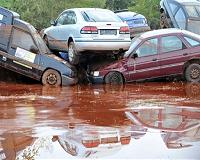| . |  |
. |
Bloomington IN (SPX) Oct 18, 2010 The red, metal-laden sludge that escaped a containment pond in Hungary last week could be made less toxic with the help of carbon sequestration, says an Indiana University Bloomington geologist who has a patent pending on the technique. The bauxite residue now covers 40 square kilometers south of the Danube River, and has caused the deaths of eight Hungarians and injured at least 150. The residue also has caused the extinction of life in a local river and as yet unknown environmental damage elsewhere. While human deaths in the wake of the disaster may have been strictly a result of the containment failure, injuries have mostly been attributed to the chemical properties of the sludge, whose high pH (between 11 and 13) can quickly damage and kill living cells. Bauxite residue is between 10,000 and 1,000,000 times more basic than pure water, which has a pH around 7. "We propose one way to reduce the pH of bauxite residue is to mix it with another kind of industrial waste - oil-field brine, which is a by-product of oil and gas production - and then carbon dioxide," said IU Bloomington geologist Chen Zhu, who submitted a U.S. Department of Energy patent application in 2007 describing the technique. The water-based brine provides the medium for carbon dioxide to dissolve. Once dissolved, the carbon dioxide can chemically react with water to form carbonic acid. The carbonic acid counteracts some of the red mud's alkalinity, and what's left - the negatively charged carbonate - can serve as a partner for positively charged metal ions, such as iron, calcium and magnesium. Some of these salts spontaneously precipitate out of solution, which is a good thing, since the metals in these salts will longer will be free to interact with, say, living matter. Bauxite residue, sometimes called "red sludge" or the more euphemistic "red mud," is the waste created by industries that produce aluminum. At present, the residues simply accrue in containment ponds. Worldwide, there are in excess of 200 million tons in these ponds. "Companies don't voluntarily spend money to neutralize waste unless someone tells them to do it, sadly," Zhu said. "Our technique could be quite expensive. When you have a disaster like the one we're seeing in Hungary, though, I think perhaps companies and governments may think twice about what 'too expensive' means." The combination of bauxite residue and oil-field brine is a novel approach to waste disposal, but this isn't an instance where the combination of two negatives equals a positive. It's more of a less-negative, Zhu says. "By reducing the pH and causing the precipitation of problematic salts, what we're left with is not something that's non-toxic, but less toxic than what we started with," he says. "Every year millions of tons of bauxite residues are being generated by industry around the world. Disposal ponds are where most of it goes. There is a great need for research on how to improve disposal." Zhu is working with the American aluminum producer Alcoa and the Department of Energy to perfect the technology.
Share This Article With Planet Earth
Related Links Indiana University Our Polluted World and Cleaning It Up
 Hungary to maintain state of emergency after toxic spill
Hungary to maintain state of emergency after toxic spillBudapest (AFP) Oct 16, 2010 Hungary's government said Saturday it wanted to extend a state of emergency in the area hit by a toxic spill two weeks ago, as experts revealed serious defects in the dam that caused the disaster. "The government will suggest to parliament to extend the state of emergency in the counties of Veszprem, Gyor-Moson-Sopron and Vas due to the effects of the red mud spill," national disaster chief ... read more |
|
| The content herein, unless otherwise known to be public domain, are Copyright 1995-2010 - SpaceDaily. AFP and UPI Wire Stories are copyright Agence France-Presse and United Press International. ESA Portal Reports are copyright European Space Agency. All NASA sourced material is public domain. Additional copyrights may apply in whole or part to other bona fide parties. Advertising does not imply endorsement,agreement or approval of any opinions, statements or information provided by SpaceDaily on any Web page published or hosted by SpaceDaily. Privacy Statement |